Taq Bostan | Sassanid Rock Reliefs in Kermanshah, Iran
Taq Bostan is a magnificent historical site located in the city of Kermanshah, Iran.
This ancient complex is renowned for its intricate rock reliefs and stunning architecture, making it a must-visit destination for history and art enthusiasts. With a rich history dating back to the Sassanid Empire, at Taq Bostan, every carving, every intricate detail, tells a story of ancient Persia's grandeur and artistic prowess.
Join our exploration as we dive into the intriguing history encapsulated within this noteworthy site.
Taq Bostan Meaning
Its name translates to "Arch of the Garden" in Farsi, but the original pronounciation of Taq Bostan is “Taq-Vah-San” in the local dialect. In Kurdish, "Taq" means "arch," and "Vasān" means "from stone," directly translating to "Stone Arch." Historically, it has been known by various names such as Qasr-e Shirin, Taq-e Bistoon, Takht-e Bostan, Taq-e Behistun, Shabdiz, and Taq-e Vastām, among which "Taq Vasān" holds particular relevance.
Historical Background of Taq Bostan
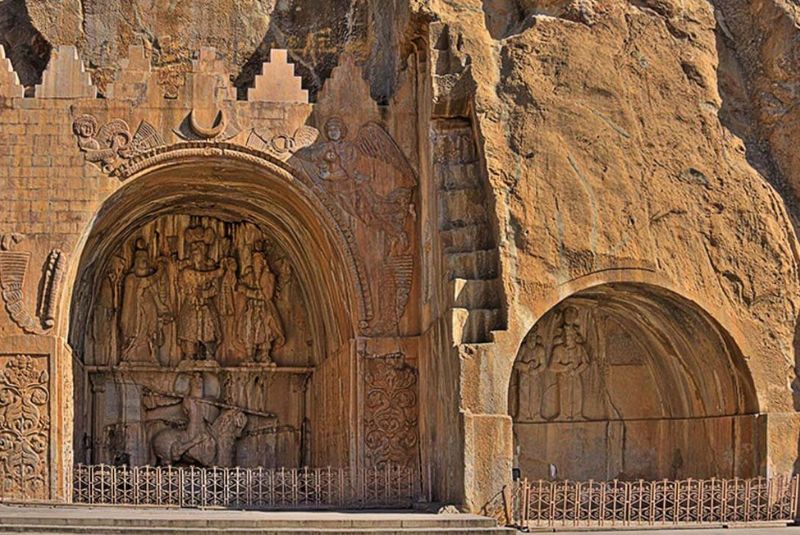
The history of Taq Bostan dates back to the Sassanid Empire, spanning from the 4th to the 7th centuries CE. This site witnessed a notable chapter during the rule of King Khosrow II (590–628 CE), marked by the creation of intricate rock reliefs etched onto the cliffs. These reliefs depict royal ceremonies, hunting scenes, and military triumphs, serving as visual narratives that glorify the might of the Sassanid rulers.
The decision to designate Taq Bostan as a commemorative site reflects the Sassanids' intentional emphasis on showcasing their power against the backdrop of nature. The reliefs, characterized by detailed depictions of attire, weaponry, and facial features, showcase the artistic prowess of the Sassanid era. Elements such as royal crowns and mythical figures add depth to the cultural and religious context of the site.
Notably, the Sassanid kings initially considered the historical complex of Persepolis as the primary location for carving statues during their reign. However, after the rule of Ardeshir II (Sassanid king from 379 to 383 AD), Taq Bostan was chosen as the optimal site for inscriptions, given its strategic geographical position along the Silk Road and captivating natural beauty. The region, with pristine springs and the remnants of a bridge near the Ardeshir relief, was chosen to symbolize the grandeur of Sassanid kings around 13 centuries ago.
Arthur Christensen identified the Bostan arch complex as the shrine of Anahita, proposing that the first Sassanid kings carved their images in the Persepolis surroundings. Archaeologists and historians estimate the antiquity of the inscriptions in Taq Bostan, including stone inscriptions, to the third century AD, during the reign of the Sassanid kings.
Ongoing archaeological endeavors continually unveil artifacts and inscriptions, contributing to a nuanced understanding of Taq Bostan's historical and cultural significance. Today, the site stands as a tangible connection to a bygone era, with preservation efforts reflecting its importance both nationally and internationally.
In recognition of its cultural and historical significance, Taq Bostan was inscribed on the UNESCO World Heritage List, attaining this esteemed status in 2007.
| Related: Bisotun; The Ancient Complex in Western Iran
The Reliefs and Inscriptions of Taq Bostan
Taq Bostan, along with its construction site, is renowned as the hunting ground of Sassanid kings. It is considered the world's first petroglyph to faithfully adhere to painting rules and principles. The intricate carvings in this petroglyph bring to life a captivating and commendable painting.
The Bostan arch comprises two connected arches, hewn into the heart of the mountain, constructed from raw gray stone. This complex is divided into several sections, each narrating a unique story with historical significance.
| Discover: Naqsh-e Rustam
Small Arch - Coronation of Shahpur II and III
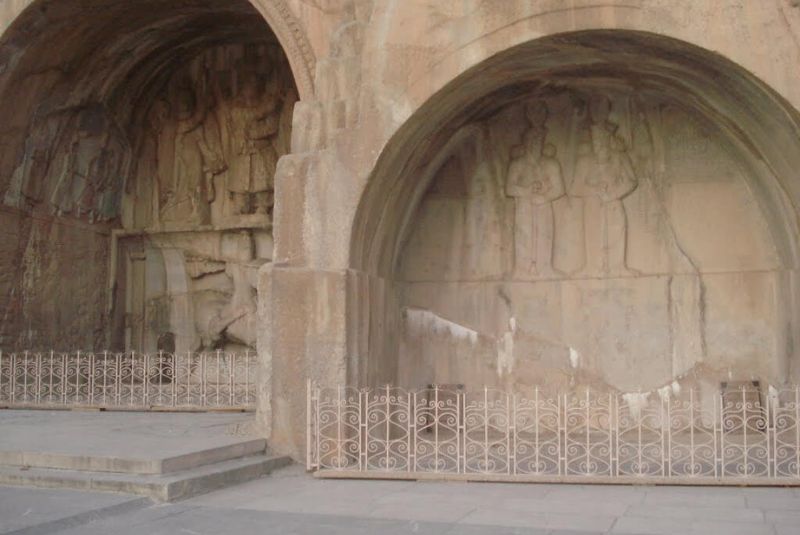
The creation of the Small Arch at Taq-e Bostan drew inspiration from Shapur I's commissioned work in a natural cave at Bishapur. Shapur III (383-388), Ardashir II's successor, replicated the concept of an artificial cave.
Shapur III had the second grotto (from left to right) shaped like an iwan, influenced by sculptures representing his investiture alongside his father Shapur II's effigy (309-379). This design served to legitimize Shapur III's assumption of power as the Sasanian King of Iran from 383 to 388, succeeding his uncle Ardashir II.
During his brief reign, Shapur III diplomatically resolved the Armenia dispute, with most of the region remaining under Sasanian control. However, he faced a significant setback in the east, losing control of Kabul to the nomadic Alchon Huns. This loss was notable as Kabul had been a vital center for coin minting since the 360s.
Inscriptions found next to the two standing kings at the Small Arch of Taq-e Bostan are written in Pahlavi script from the late fourth century CE. These nearly identical inscriptions provide general information about the two kings, initially introduced as Magis of Ahura Mazda, signifying their roles as priests in Zoroastrianism and earlier religions of the western Iranians.
“Behold the portrayal of Šāpūr, the Mazda-worshipping Magi, proclaimed as the king of kings over both Iranians and non-Iranians. His divine lineage traces back to the gods, being the son of the Mazda-worshipping lord, Hormizd, who held the esteemed title of king of kings over Iranians and non-Iranians. Šāpūr is further identified as the grandson of the lord Narsē, who also held the distinguished position of king of kings.”
| Read more: Frieze of Archers; The Ancient Persian Power
Great Arch - Coronation of Khosrow Parviz

Taq Bostan comprises various elements, with the Large Arch being a notable monument likely dating back to Piruz's reign (457-484) and possibly completed during Khosrow II's era (590-628). This arch, potentially the focal point of a three-grotto complex, remains unfinished, likely due to the Sassanian Empire's collapse under Arab conquest.
| Learn more: Why Iran is Not an Arab Country?
The entrance to the Large Arch showcases an elegant arch on the iwan facade, featuring intricate floral motifs and 'angels' reminiscent of Roman winged victories. The ethereal grace is enhanced by the presence of female figures representing Anahita and the Victories, softening the Sassanian pantheon.
Inside the grotto, an apse reveals two registers. The lower register depicts a larger-than-life 'horseman,' likely King Piruz, wielding a lance and shield on a caparisoned steed, symbolizing feudal combat. The upper register showcases Khosrow II between Anahita and Ahura Mazda, receiving a ribboned crown.
Additionally, a Qajar bas-relief with Nastaliq script inscription on the porch's left wall portrays a seated Qajar governor and prince. The prince wears a congressional crown, a red pleated shirt, and a belt, holding a word and a dagger.
| Also read: Pasargadae; Legacy of Cyrus the Great & Ancient City
Scene of Ardashir II

Before the construction of the arches, Ardashir II (379-383) initiated the carving of the first relief at Taq-e Bostan. This depiction portrays the Sasanian king in the act of being crowned. Standing triumphantly on a defeated Roman Soldier, Ardashir II receives a ribboned crown symbolizing his authority from the gods Mithra and Ahuramazda.
Ardashir II, who reigned as the Sasanian King from 379 to 383 AD, was the brother of his predecessor, Shapur II (r. 309–379). Serving as a vassal king of Adiabene under his brother, Ardashir II fought alongside Shapur II against the Romans. After Shapur II's death, Ardashir II was appointed as his brother's interim successor until Shapur III, the son of Shapur II, reached adulthood. Ardashir II's brief reign was relatively uneventful, marked by the Sasanians' unsuccessful efforts to maintain control over Armenia.
| Suggestion: Why Did Persia Change Its Name to Iran?
The Relief of Mohammad Ali Mirza
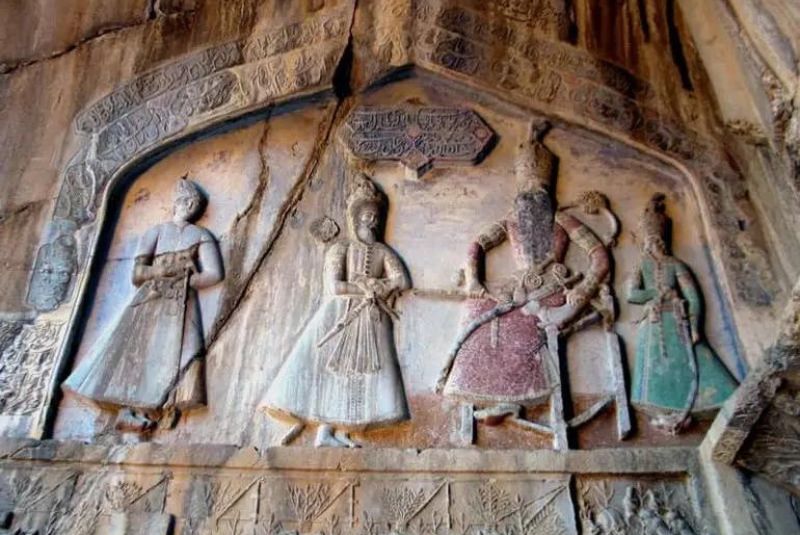
A regrettable episode in the history of this esteemed site unfolded during the 19th-century Qajar era when Mohammad Ali Mirza initiated the carving of a bas-relief. Unfortunately, this endeavor resulted in significant harm to the unique Iranian heritage of the site.
These incongruous and aesthetically lacking images depict Mohammad Ali Mirza, the son of Fath-Ali Shah Qajar, alongside his sons, and Agha Ghani, the royal chamberlain, standing before him. In his travelogue, Naser al-Din Shah Qajar expressed his disapproval of these depictions, stating: "Above this page, Agha Ghani, the chamberlain of the late Mohammad Ali Mirza, who hailed from Talesh, Gilan, has carved the portrait of the late prince, seated with his son Hashmat al-Dowleh and his younger son. Agha Ghani is also depicted standing in front of the prince in an unsightly manner. The execution is truly appalling and has marred the arch, with the poorly rendered figures being colored. Undoubtedly, it has compromised the beauty of the arch."
| Read about: Firuzabad, The Ancient Capital | The Rise and Fall of Gor City
Boar Hunting Relief
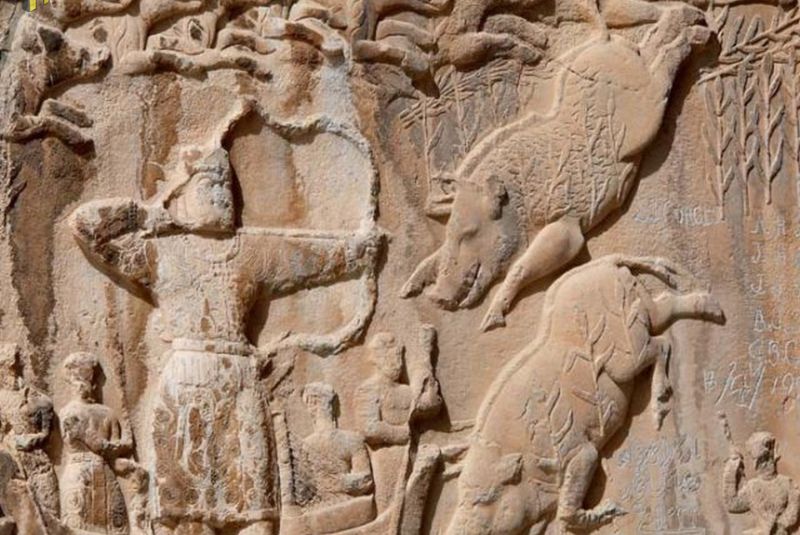
This historical bas-relief, illustrating a boar hunt, extends approximately 6 meters in length and 4 meters in width. At the heart of the scene, the king, positioned on a boat armed with a bow and arrow, takes aim at two boars hastening towards him. Occupying the king's boat are four additional figures, featuring rowers at the front and back, a servant, and seemingly a harpist.
On the left side of the composition, 12 elephants are intricately carved, each carrying two riders. These elephant riders play a role in driving the boars out of their hiding places. Positioned behind the king's boat is another watercraft, showcasing female musicians engaged in playing instruments.
The depiction of the king standing on the boat, bow in hand, symbolizes the conclusion of the hunt. In the final segment of the scene, five elephant riders are depicted gathering the hunted boars.
| Discover: Zoroastrian Towers of Silence
Armored Horseman Relief (Cataphract)

This prominent relief features a figure seated on a robust horse, shown in a three-quarter face view and a full-frontal body orientation. While the rider's identity remains uncertain, the depiction symbolizes the regality and strength of both the king and the Iranians. Multiple narratives surround this warrior, with some interpreting him as a combatant, while others suggest the figure represents Khosrow Parviz mounted on his renowned horse, Shabdiz.
The rider is adorned with a helmet concealing his face, leaving only his eyes visible, and a crown is also prominently displayed. His attire includes a shirt embellished with depictions of birds and mythical creatures, complemented by chainmail armor extending down to the knees. A decorative belt is visibly worn around his attire.
Attached to the belt is a quiver, and the rider holds a long spear, indicating preparedness for battle. Additionally, the figure wields a circular shield for defense. The horse itself is adorned with ornamental tassels, adding to the overall visual spectacle.
| Suggestion: Cyrus The Great – The Most Powerful King in The World
Deer Hunting Relief

The petroglyph illustrates elephant guides leading deer to the hunting ground gate. The king, mounted on a horse, is shown hunting deer, accompanied by women playing musical instruments. The subsequent scenes depict the chase and capture of deer, with camel riders transporting the hunted animals.
| Discover: Top 10 Historical Sites of Iran
Taq Bostan Stone Museum
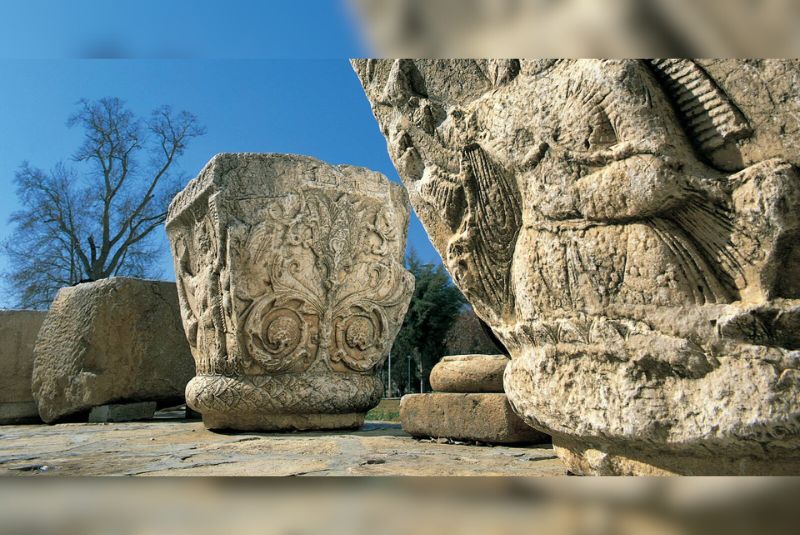
Taq-e Bostan Stone Museum, situated north of Taq Bostan Boulevard, is another captivating feature within this complex. After exploring the Taq-e Bostan site, taking a tour of this museum is a worthwhile endeavor. It exhibits stone artifacts dating back to the Sassanid and Islamic periods, encompassing Sassanid capitals adorned with depictions of Anahita, Ahura Mazda, and the Tree of Life, a bust attributed to Khosrow Parviz, and remnants of the Qajar era palace in Qasr-e Shirin.
The museum derives its name, the Stone Museum, from the array of stone artifacts it houses. For those intrigued by Iran's ancient history and its rich collection of artifacts, a visit to this museum comes highly recommended.
| Learn about: Persian Empire; Facts & History of Achaemenids
The Spring Site of Taq-e Bostan
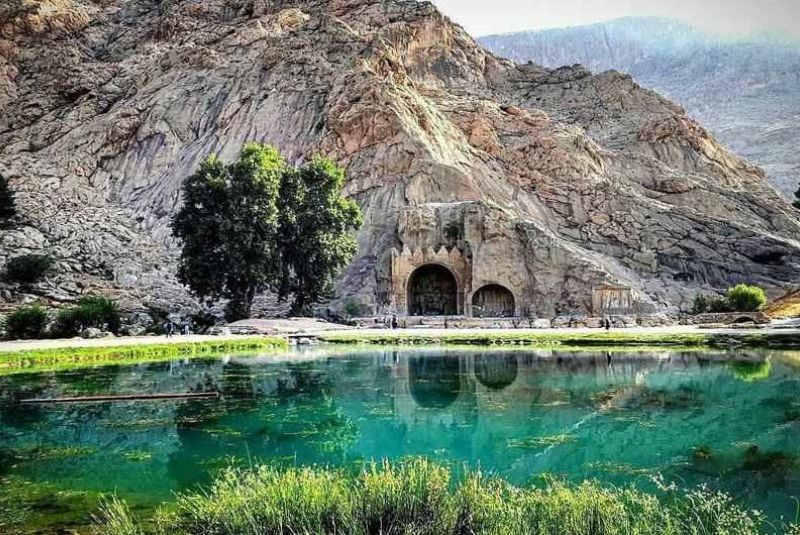
In Kermanshah, Taq e Bostan is not only renowned for its ancient Sassanid relics but also for its millennia-old water springs. In the Sassanid era, these springs played a crucial role as a source of drinking water and irrigation for agriculture.
Today, these ancient springs continue to supply drinking water to the village of Taq-e Bostan, contributing to the area's lush and beautiful natural surroundings. When you visit Taq e Bostan, you will encounter a stream flowing in front of the site, showcasing the presence of small water springs. The water's clarity and coolness persist to this day, with its refreshing chill making it challenging to keep your hand submerged even during the summer months.
| Read more: Throne of Solomon, One of Iran's UNESCO World Heritage Site
Taq Bostan Location and Climate

Taq-e Bostan is located in the Zagros Mountains, a mere 5 km from Kermanshah. Originally adorned with natural springs, some concealed while others persist, these springs contribute to the site's beauty, feeding into a basin in front of the rock. The reliefs and arches of Taq-e Bostan, chiseled into the mountain's core, serve as enduring testaments to the artistic excellence of the Sassanian era.
As situated in a mountainous terrain, Taq-e Bostan enjoys a cool climate. Spring unveils lush greenery, creating a spectacle, while autumn adds charm with multicolored leaves. Summers offer a temperate climate, allowing visitors to relax by the lake. Winters, draped in a white cloak, bring enchantment to Taq e Bostan.
During your exploration of this historical site, you may encounter a significant ancient tree. This robust tree, standing for over six centuries, serves as Taq e Bostan's distinctive signature, providing a memorable experience for those capturing memories alongside it.
| Also read: Iran's Natural Attractions
Best Time to Visit Taq Bostan
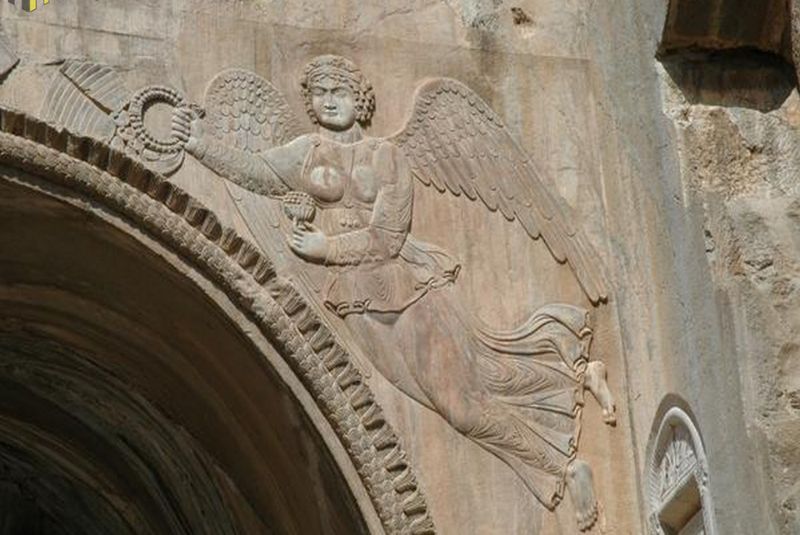
The best times to visit Taq Bostan are during spring (April to June) and autumn (September to November) for mild and pleasant weather. Summers (July to August) are also suitable, while winters (December to February) can be cold with potential snowfall. Overall, spring and autumn offer optimal conditions to explore the site comfortably.
| Might be useful to read about: Iran's Four Seasons
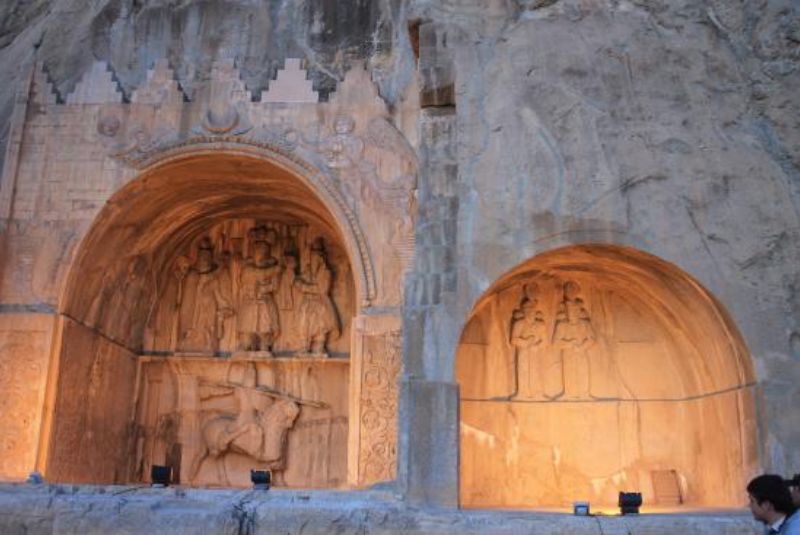
Final Takeaway
Whether one is drawn to the site for its historical significance, architectural marvels, or simply to connect with the roots of Persian culture, Taq Bostan stands as a bridge between the past and the present. It is an invitation to contemplate, appreciate, and reflect on the remarkable journey that has shaped Kermanshah's cultural identity.
Share your story!
Comment below and let us know about your Experience.
Your story inspires others!


Comment
Leave a Comment